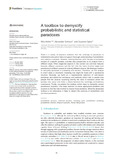Citation link:
10.3389/feduc.2023.1212419| DC Field | Value | Language |
|---|---|---|
| crisitem.author.orcid | 0000-0001-9068-5696 | - |
| crisitem.author.orcid | 0000-0002-3749-3991 | - |
| dc.contributor.author | Kelter, Riko | - |
| dc.contributor.author | Schnurr, Alexander | - |
| dc.contributor.author | Spies, Susanne | - |
| dc.date.accessioned | 2023-12-20T13:16:04Z | - |
| dc.date.available | 2023-12-20T13:16:04Z | - |
| dc.date.issued | 2023 | de |
| dc.description | Finanziert aus dem DFG-geförderten Open-Access-Publikationsfonds der Universität Siegen für Zeitschriftenartikel | de |
| dc.description.abstract | There is a variety of empirical evidence that the coverage of paradoxes in mathematics education helps to support thorough understanding of probabilistic and statistical concepts. However, existing literature often focuses on extensive analysis of a specific paradox, provides new perspectives or an analysis from a different angle. Often neglected aspects in this context are common features between different paradoxes and the fact, that the same situation might look paradoxical to different people for entirely different reasons. We develop a toolbox to demystify paradoxes in probability and statistics. Therefore, we first analyze in which steps of stochastic modeling one might be faced with a paradoxical situation. Secondly, we build on a representative selection of well-known paradoxes and isolate the techniques and methods which help to explain why people find the paradox surprising, identify the class of scenarios where the paradox may occur and make a choice between the seemingly contradictory conclusions. Thirdly, we present the toolbox, which helps to demystify various paradoxical situations. This helps teachers to chose appropriate problems and students to find the right method to resolve these problems. While the developed toolbox is not exhaustive, it helps to dissect the anatomy of probabilistic and statistical paradoxes. | en |
| dc.identifier.doi | 10.3389/feduc.2023.1212419 | de |
| dc.identifier.uri | https://dspace.ub.uni-siegen.de/handle/ubsi/2578 | - |
| dc.identifier.urn | urn:nbn:de:hbz:467-25784 | - |
| dc.language.iso | en | de |
| dc.rights | Attribution-NonCommercial-NoDerivatives 4.0 International | * |
| dc.rights.uri | http://creativecommons.org/licenses/by-nc-nd/4.0/ | * |
| dc.source | Frontiers in education ; 8, 1212419 - https://doi.org/10.3389/feduc.2023.1212419 | de |
| dc.subject.ddc | 510 Mathematik | de |
| dc.subject.other | Probabilistic paradox | en |
| dc.subject.other | Statistical paradox | en |
| dc.subject.other | Modeling cycle | en |
| dc.subject.other | Probabilistic modeling | en |
| dc.subject.other | Probabilistic intuition | en |
| dc.subject.other | Simpson’s paradox | en |
| dc.subject.other | Monty Hall paradox | en |
| dc.subject.other | Probabilistisches Paradoxon | de |
| dc.subject.other | Statistisches Paradoxon | de |
| dc.subject.other | Modellierungszyklus | de |
| dc.subject.other | Probabilistische Modellierung | de |
| dc.subject.other | Probabilistische Intuition | de |
| dc.subject.other | Simpson'sches Paradoxon | de |
| dc.subject.other | Monty-Hall-Paradoxon | de |
| dc.title | A toolbox to demystify probabilistic and statistical paradoxes | en |
| dc.type | Article | de |
| item.fulltext | With Fulltext | - |
| ubsi.publication.affiliation | Department Mathematik | de |
| ubsi.source.doi | 10.3389/feduc.2023.1212419 | - |
| ubsi.source.issn | 2504-284X | - |
| ubsi.source.issued | 2023 | de |
| ubsi.source.issuenumber | 8 | de |
| ubsi.source.pages | 12 | de |
| ubsi.source.place | Lausanne | de |
| ubsi.source.publisher | Frontiers Media | de |
| ubsi.source.title | Frontiers in Education | de |
| Appears in Collections: | Geförderte Open-Access-Publikationen | |
Files in This Item:
| File | Description | Size | Format | |
|---|---|---|---|---|
| A_toolbox_to_demystify_probabilistic_and_statistical_paradoxes.pdf | 1.22 MB | Adobe PDF |  View/Open |
This item is protected by original copyright |
Page view(s)
241
checked on Nov 30, 2024
Download(s)
117
checked on Nov 30, 2024
Google ScholarTM
Check
Altmetric
This item is licensed under a Creative Commons License


